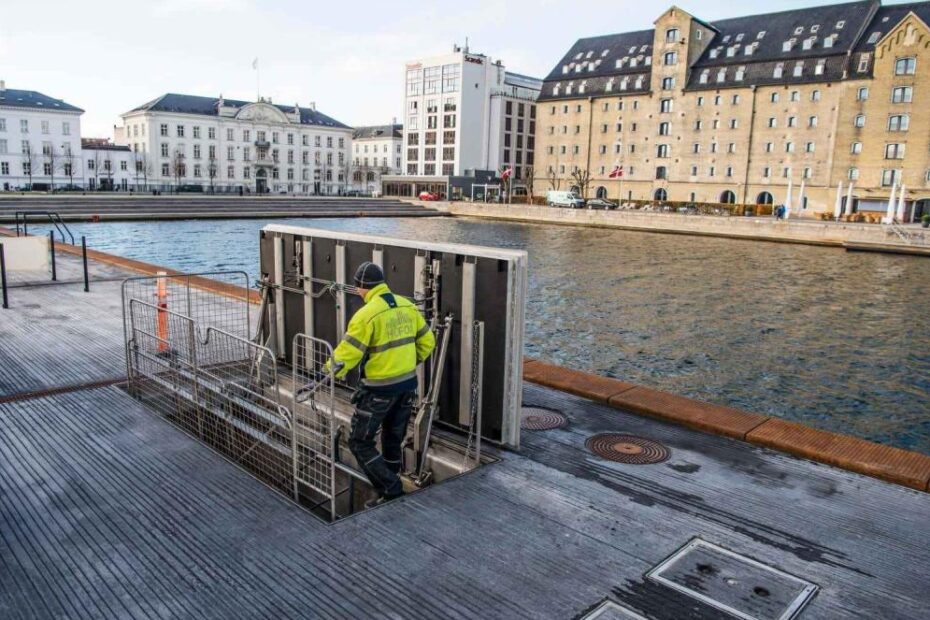The concept of district cooling includes the systems which generate cold water in a central system which is then distributed with well-insulated pipes to different users including hotels.
- One-third of Copenhagen’s hotel rooms are now cooled with seawater
By pumping cool seawater through pipes in a renewable cycle, hotels are cooling down tourists in the Danish capital.
Hotels in the Danish capital are utilizing district cooling to chill down guests. By pumping water from the port through pipes in a renewable cycle, the solution both reduces CO2 emissions and trims energy consumption.
As of 2023, approximately 8,500 hotel rooms have been equipped with innovative air conditioning systems powered by seawater. This is an increase of 112.5% from 2018.
The water is derived from the Port of Copenhagen, and the solution is called district cooling, which is attractive as it emits less CO2 than traditional electric air conditioning systems.
Copenhagen comprises just under 24,000 hotel rooms, and Scandic Hotels is one of the hotel chains that makes use of district cooling.
In addition to this, district cooling similarly allows for better utilization of the properties’ valuable square meters. Jakob Thanning elaborates on this by mentioning that the district cooling solution allows for more room on building facades and rooftops, as the system is contained underground. This is essential in a city like Copenhagen, as space is becoming increasingly scarce. Also, in terms of accommodating the many tourists flocking to the Danish capital.
2. China’s island resort deploys low-carbon district cooling in hotels
HAIKOU – Sanya, a resort city on China’s tropical island of Hainan, has replaced air conditioners with a centralized supply of cold water in several high-end hotels and duty-free shops, raising new prospects for a greener solution to the summer heat in China.
The district cooling system, in which chilled water is produced and distributed by a central source to cool multiple buildings in an area, has become a talking point on China’s internet amid the current heatwave. It has gained attention for its promise of providing cool environments with more efficient energy use.
In Sanya, seven hotels, are using the city’s district cooling system.
Haitang Bay is home to a cluster of luxury hotels, including Westin, Edition and Fairmont.
The district cooling network in Sanya sends out water at 7 degrees (70C) Celsius via a pipe system. District cooling systems enjoy economies of scale and optimized central management, making them much more energy efficient than individual air conditioners.
Launched in 2021, the Sanya system is capable of saving about 28,000 tons of standard coal and reducing 76,000 tons of carbon dioxide emissions every year when running at full tilt, according to the supplier.
For hotels, the use of district cooling can also reduce bacteria and noise pollution compared to traditional cooling systems.
3. District Cooling System – Gulf Hotels Group Bahrain
The district cooling system is located in and around the premises of the Gulf Hotel Complex in Juffair area of Bahrain.
Description:
The Complex is an existing private commercial facility, providing high quality residential, commercial and hotel accommodation, as well retail shops, restaurants, conference facilities, spa, laundry, recreation and car park areas.
The system comprises of both water and air-cooled chillers (the latter providing only standby capacity). Each chiller in the District Cooling system facilitates its own duty and stand-by constant speed primary pumps. Chilled water supply is then transferred to a common manifold (with a by-pass to ensure minimum flow through the operational chiller) and through variable flow secondary pumps is distributed to the plate heat exchangers of the primary circuits in all building plant rooms. Water-cooled centrifugal chillers are connected to cooling towers equipped with variable speed cooling water pumps and variable speed tower fans to ensure optimum operation as well as energy efficiency.
The District Cooling system is connected to the BMS whose task is to monitor the performance of the system, adapt it to ambient conditions and cooling load variations throughout the day and the season and record all operational parameters, including energy demand, flows through various components, temperatures, pressures, etc.
The district Cooling major equipment installed include:
- 4 – Water-cooled Chillers
- 3 – Air-cooled standby Chillers
- 6 – Cooling Towers
- 14 – Heat Exchangers
